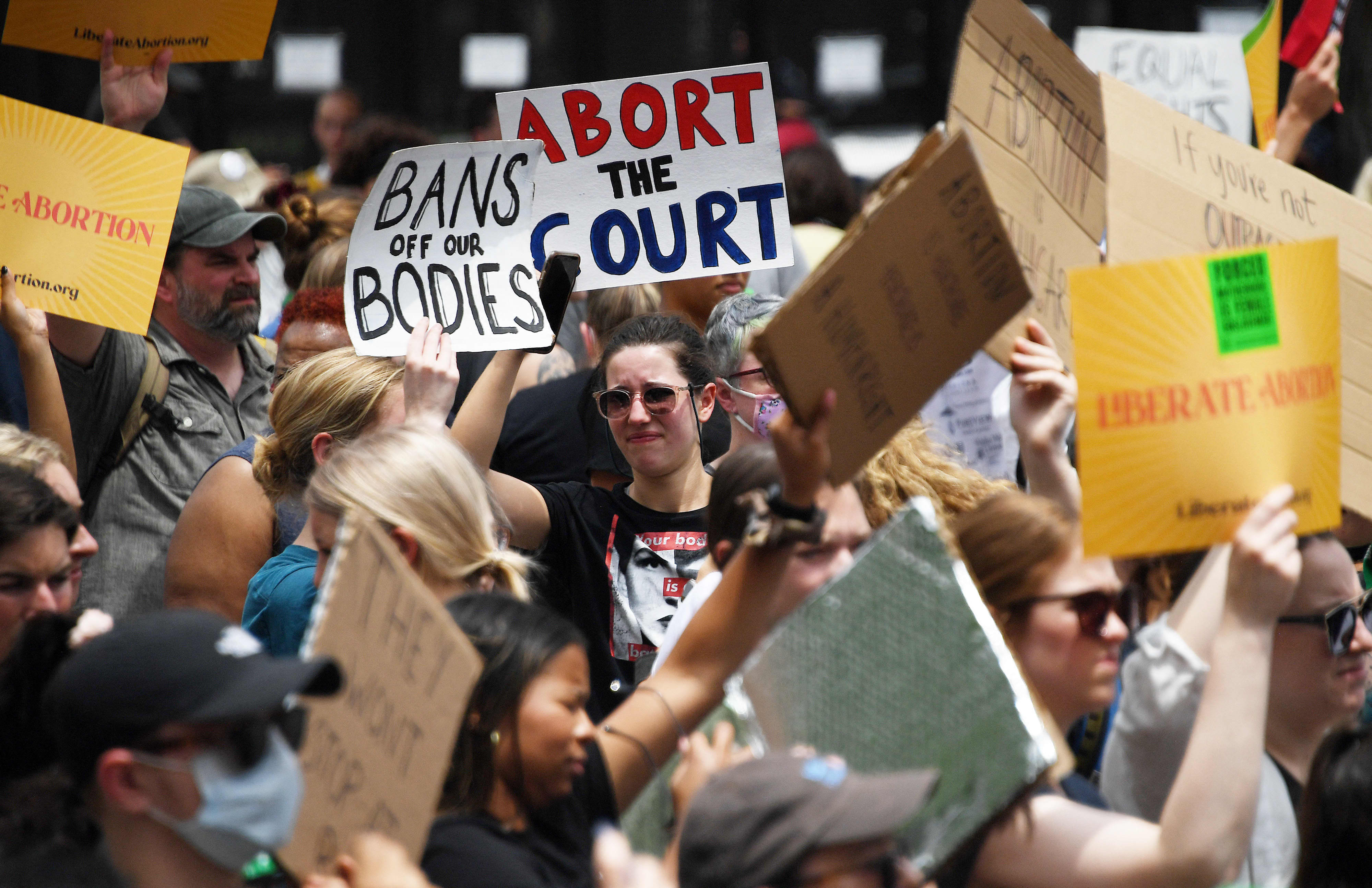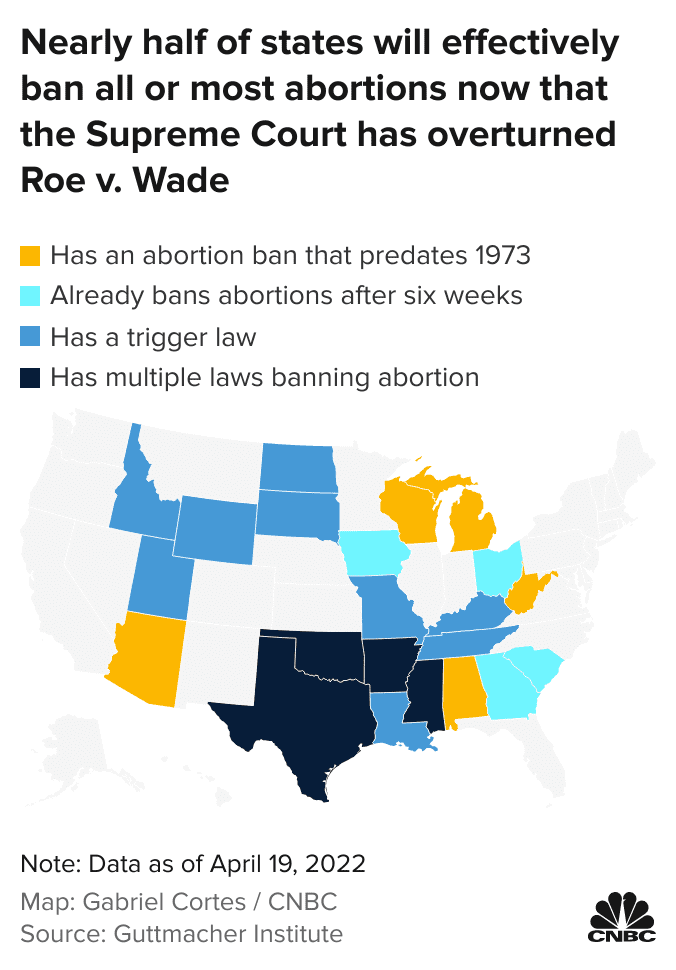A momentous ruling by the Supreme Court overturning the landmark and decades-old Roe v. Wade decision will likely lead to abortion bans in roughly half the states.
In California, wheels began turning long before Friday's ruling and rolling in the opposite direction, including a proposal to ensure voters have a chance this fall to make abortion a constitutional right in the nation's most populous state.
"The impact on woman in California is negligible because California protects reproductive rights through its constitution and through statutes," said Cary Franklin, UCLA faculty director of the Center on Reproductive Health, Law and Policy. "Abortions will proceed in California. California women are fully protected.
"That is not true in every state."
In the hours after the ruling, California Gov. Gavin Newsom said the decision stripped away liberties and "let other states replace them with mandated birth."
Newsom and the Democratic governors of Washington and Oregon on Friday vowed to protect reproductive rights and help women who travel to the West Coast seeking abortions. The three states are building a “West Coast offense” to protect patients’ access to reproductive care, Newsom said in a video statement announcing the plans along with Oregon Gov. Kate Brown and Washington Gov. Jay Inslee.
California already has some of the most expansive abortion laws in the country, but a proposed amendment to the California Constitution would explicitly ban the state from denying or interfering with abortions or contraceptives. That measure cleared two legislative committees in a single day last week.
California protects abortion access through privacy rights, but the bill's supporters say the amendment will serve as an explicit guarantee.
The amendment needs voter approval before it can become law.
Get a weekly recap of the latest San Francisco Bay Area housing news. Sign up for NBC Bay Area’s Housing Deconstructed newsletter.
If it makes the ballot this fall, it's likely to pass. Among likely voters, 76% oppose overturning Roe v. Wade, according to an April survey by the Public Policy Institute of California.
The amendment says the state of California "shall not deny or interfere" with people's "fundamental right to choose" to have abortions.
Opponents warned that wording was so broad that it would permit abortions even after the viability of a fetus, which California currently only allows if the life or health of the mother is in danger.
“California will not sit on the sidelines as unprecedented attacks on the fundamental right to choose endanger women across the country," Gov. Newsom said in an earlier statement. "This measure will ensure that women in our state have an inviolable right to a safe and legal abortion that is protected in our constitution. I thank Senate President pro Tempore Atkins and Assembly Speaker Rendon for their leadership and look forward to our continued partnership to advance California’s nation-leading commitment to protecting and strengthening access to reproductive health care services in our state.”
What are the laws that protect abortion access in California?
California has already taken several steps to protect access to abortions. The state uses tax dollars to pay for abortions of people on its Medicaid program, requires private insurance companies to cover the procedures without charging a co-pay or a deductible, and allows minors to get abortions without their parent's permission.
All of that is possible because, in 1972, California voters added a right to privacy to the state constitution. State courts have cited that right to privacy while upholding many of the state's abortion laws. Roe v. Wade, the U.S. Supreme Court's landmark 1973 decision that prevents states from banning all abortions, was based on the U.S. Constitution's implied right to privacy.
The proposed amendment is one of 14 proposals moving through the California Legislature this year to strengthen and expand access to abortion. Anti-abortion advocates have tried in vain to slow them down, with hundreds rallying outside the state Capitol and flooding the phone lines during public comment periods of legislative hearings.
California is one of 16 states and the District of Columbia with protections for abortion access in state law, although all take slightly different approaches.
Colorado, New Jersey, Oregon, Vermont and D.C. protect the right to abortion throughout the entire pregnancy. Twelve other states – California, Connecticut, Delaware, Hawaii, Illinois, Maine, Maryland, Massachusetts, Nevada, New York, Rhode Island, and Washington – have laws to protect the right to abortion prior to viability.
California, Colorado, Oregon, Vermont, Washington, New Jersey, Maryland and Connecticut are among the state that have moved to strengthen existing protections or add to them in the past year.
How did the Supreme Court rule on abortion?
The Supreme Court ended constitutional protections Friday for abortion that had been in place nearly 50 years. The decision was telegraphed in a draft ruling leaked earlier this year.
The decision, unthinkable just a few years ago, was the culmination of decades of efforts by abortion opponents, made possible by an emboldened right side of the court that has been fortified by three appointees of former President Donald Trump.
The ruling came more than a month after the stunning leak of a draft opinion by Justice Samuel Alito indicating the court was prepared to take this momentous step. Alito, in the final opinion issued Friday, wrote that Roe and Planned Parenthood v. Casey, the 1992 decision that reaffirmed the right to abortion, were wrong the day they were decided and must be overturned.
“We hold that Roe and Casey must be overruled. The Constitution makes no reference to abortion, and no such right is implicitly protected by any constitutional provision,” Alito wrote.
Authority to regulate abortion rests with the political branches, not the courts, Alito wrote.
Joining Alito were Justices Clarence Thomas, Neil Gorsuch, Brett Kavanaugh and Amy Coney Barrett. The latter three justices are Trump appointees. Thomas first voted to overrule Roe 30 years ago.
Chief Justice John Roberts would have stopped short of ending the abortion right, noting that he would have upheld the Mississippi law at the heart of the case, a ban on abortion after 15 weeks, and said no more.
Justices Stephen Breyer, Sonia Sotomayor and Elena Kagan — the diminished liberal wing of the court — were in dissent.
“With sorrow—for this Court, but more, for the many millions of American women who have today lost a fundamental constitutional protection—we dissent,” they wrote.
Thirteen states, mainly in the South and Midwest, already have laws on the books that ban abortion in the event Roe is overturned. Another half-dozen states have near-total bans or prohibitions after 6 weeks of pregnancy, before many women know they are pregnant.
In roughly a half-dozen other states, the fight will be over dormant abortion bans that were enacted before Roe was decided in 1973 or new proposals to sharply limit when abortions can be performed, according to the Guttmacher Institute, a research group that supports abortion rights.
More than 90% of abortions take place in the first 13 weeks of pregnancy, and more than half are now done with pills, not surgery, according to data compiled by Guttmacher.
The Biden administration and other defenders of abortion rights have warned that a decision overturning Roe also would threaten other high court decisions in favor of gay rights and even potentially, contraception.
But Alito wrote in his draft opinion that his analysis addresses abortion only, not other rights that also stem from a right to privacy that the high court has found implicit, though not directly stated, in the Constitution. Abortion is different, Alito wrote, because of the unique moral question it poses.
Whatever the intentions of the person who leaked Alito’s draft opinion, the conservatives held firm in overturning Roe and Casey.
In his draft, Alito dismissed the arguments in favor of retaining the two decisions, including that multiple generations of American women have partly relied on the right to abortion to gain economic and political power.
Changing the composition of the court has been central to the anti-abortion side’s strategy. Mississippi and its allies made increasingly aggressive arguments as the case developed, and two high-court defenders of abortion rights retired or died. The state initially argued that its law could be upheld without overruling the court’s abortion precedents.
Then-Gov. Phil Bryant signed the 15-week measure into law in March 2018, when Justices Anthony Kennedy and Ruth Bader Ginsburg were still members of a five-justice majority that was mainly protective of abortion rights.
By early summer, Kennedy had retired and was replaced by Justice Brett Kavanaugh a few months later. The Mississippi law was blocked in lower federal courts.
But the state always was headed to the nation’s highest court. It did not even ask for a hearing before a three-judge panel of the 5th U.S. Circuit Court of Appeals, which ultimately held the law invalid in December 2019.
By early September 2020, the Supreme Court was ready to consider the state’s appeal.
The court scheduled the case for consideration at the justices’ private conference on Sept. 29. But in the intervening weeks, Ginsburg died and Barrett was quickly nominated and confirmed without a single Democratic vote.
The stage now was set, although it took the court another half year to agree to hear the case.
By the time Mississippi filed its main written argument with the court in the summer, the thrust of its argument had changed and it was now calling for the wholesale overruling of Roe and Casey.
The first sign that the court might be receptive to wiping away the constitutional right to abortion came in late summer, when the justices divided 5-4 in allowing Texas to enforce a ban on the procedure at roughly six weeks, before some women even know they are pregnant. That dispute turned on the unique structure of the law, including its enforcement by private citizens rather than by state officials, and how it can be challenged in court.
But Justice Sonia Sotomayor noted in a searing dissent for the three liberal justices that their conservative colleagues refused to block “a flagrantly unconstitutional law” that “flouts nearly 50 years of federal precedents.” Roberts was also among the dissenters.
Then in December, after hearing additional arguments over whether to block the Texas law known as S.B. 8, the court again declined to do so, also by a 5-4 vote. “The clear purpose and actual effect of S. B. 8 has been to nullify this Court’s rulings,” Roberts wrote, in a partial dissent.
In their Senate hearings, Trump’s three high-court picks carefully skirted questions about how they would vote in any cases, including about abortion.
But even as Democrats and abortion rights supporters predicted Kavanaugh and Gorsuch would vote to upend abortion rights if confirmed, the two left at least one Republican senator with a different impression. Sen. Susan Collins of Maine predicted Gorsuch and Kavanaugh wouldn’t support overturning the abortion cases, based on private conversations she had with them when they were nominees to the Supreme Court.
Barrett was perhaps the most vocal opponent of abortion in her time as a law professor, before becoming a federal judge in 2017. She was a member of anti-abortion groups at Notre Dame University, where she taught law, and she signed a newspaper ad opposing “abortion on demand” and defending “the right to life from fertilization to natural death.” She promised to set aside her personal views when judging cases.
Trump, meanwhile, had predicted as a candidate that whoever he named to the court would “automatically” vote to overrule Roe.



